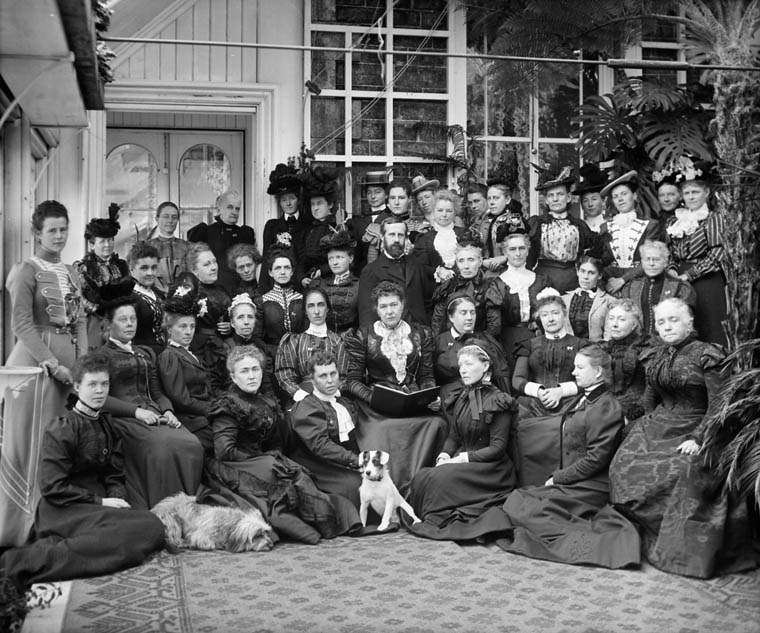
The National Council of Women of Canada (NCWC), founded in 1893, is one of Canada’s oldest advocacy groups. A non-partisan federation of voluntary women’s organizations, it is a member of the International Council of Women.
Creation
The National Council of Women of Canada (NCWC) originated with the International Council of Women (ICW). An international organization dedicated to the advancement of women, the ICW was founded by suffragists in the United States in 1888. Several Canadians were active in the ICW when it was suggested in May 1893 that a Canadian council be created. On 27 October 1893, the National Council of Women of Canada was established at a meeting in Toronto attended by 1,500 women.

The NCWC was created by Lady Ishbel Aberdeen, its first president, in order to counter Conservative-Liberal partisanship and to foster bipartisan communication for the common good. At a time when women lacked the provincial and federal vote, the NCWC hoped to become a “parliament of women,” a council in which women’s views could be presented and debated — and the pitfalls of male political partisanship avoided.

Women’s Suffrage
Lady Aberdeen was already president of the ICW when she came to Canada as the wife of the governor general in 1893. With the support of Canadian activists, including such suffragists as Dr. Augusta Stowe-Gullen, she began to create a federation that would unite various women’s groups otherwise isolated in a large country. The global linkages of the council movement soon made an important contribution to enlarging the perspective of Canadians to include international issues of justice and equality.
The NCWC initially viewed suffrage as too divisive to be adopted in Canada. Although some member societies and local councils campaigned for the vote, the NCWC rarely identified as feminist and only adopted a suffrage platform in 1910. Before that date, it expanded into all provinces, linking women in a wide range of social, philanthropic, professional and religious groups. Its cautious approach to women’s suffrage and to issues such as conscription and pacifism kept the NCWC acceptable to conservative politicians, who wanted a safe representative to the 1918 Women’s War Conference in Ottawa. Women had replaced many men in the labour force during the First World War, and the conference was called to discuss, plan and direct Canadian women’s continued contribution to the war effort (see Women and War).
French Canadians and women of colour were grossly under-represented in the NCWC and its affiliated groups. Many leading suffragists, such as Nellie McClung and Flora MacDonald Denison, regarded the NCWC as representative of elites and had little to do with the council. However, in a few cities, such as Vancouver, it was effective in fostering relatively broad coalitions of women.
Interwar Period
In the 1920s, the NCWC struggled to find its way in the world of flappers, growing acceptance of women’s paid employment and greater interest in birth control. Its middle-class respectability still sometimes made it a favourite of governments. In the 1930s, NCWC president Winnifred Kydd joined Canadian delegations to the League of Nations. In 1930, Cairine Wilson, an active member of the Ottawa Local Council of Women and a prominent Liberal, became the first woman appointed to the Senate. Despite the leadership of Wilson in the Canadian National Committee on Refugees during the 1930s, the NCWC did little to fight fascism, though it sympathized with the plight of the German Council of Women, which Adolf Hitler forced to disband. Some Local Councils of Women and nationally organized societies did, however, champion the unemployed and causes such as disarmament.
Membership and Organization
The NCWC’s federated structure, with its inclusion of local and provincial councils and national affiliates (such as the Canadian Federation of Business and Professional Women), has been both its strength and weakness. On the one hand, members link the council to many important concerns; on the other, a diversity of opinion prevents quick or sometimes any action. The longtime domination of the NCWC by White and middle-class women has also created problems in broadening its perspective and appeal.
In the 1960s and 1970s, the council supported the call for a Royal Commission on the Status of Women and later the formation of the Canadian Advisory Council on the Status of Women to help implement the commission’s report. In the 1980s, the NCWC supported the entrenchment of women’s rights in the Canadian Charter of Rights and Freedoms. By the 1990s, however, the National Action Committee on the Status of Women and the Fédération des femmes du Québec (FFQ) proved more forceful coalitions in endeavours to advance equality rights for Canadian women.
Legacy and Significance
The NCWC and its members have fostered some vital Canadian institutions, such as the Victorian Order of Nurses, children’s aid societies and the Consumers’ Association of Canada. It has also supported government agencies such as Labour Canada’s Women’s Bureau and Status of Women Canada, with their promotion of equal opportunity, pay, rights and benefits for women in employment (see Status of Women). Its persistent calls for greater justice and fairness sometimes receive official recognition. In 1997, the NCWC received Consultative Status with the Economic and Social Council (ECOSOC) of the United Nations.
The National Council of Women of Canada continues to address a wide range of issues involving women, the family, the community and the state. In the last decades of the 20th century and the first decades of the 21st, it struggled to respond to the rise of neo-liberalism and austerity regimes and to match the appeal of the more activist-minded FFQ and the National Action Committee on the Status of Women (NAC). The collapse of NAC does, however, offer greater institutional space for the older national coalition of women’s groups. It remains to be seen whether the NCWC will meet this challenge.

 Share on Facebook
Share on Facebook Share on X
Share on X Share by Email
Share by Email Share on Google Classroom
Share on Google Classroom


